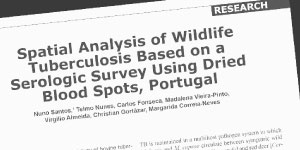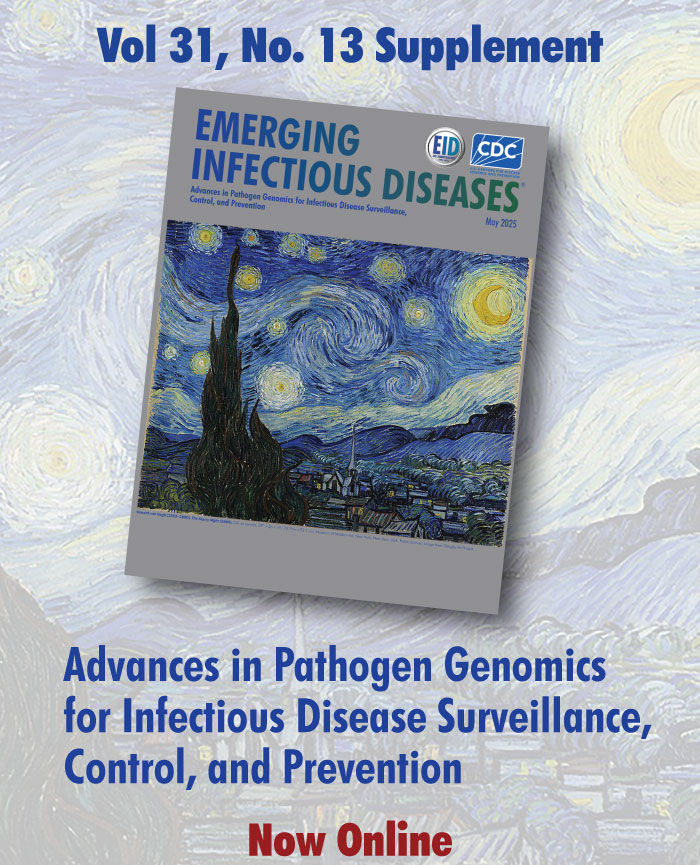Articles from Emerging Infectious Diseases
Volume 31, Number 10—October 2025
Synopses
Retrospective Analysis of Historical Listeria monocytogenes Clinical Isolates, New York, USA, 2000–2021
We used whole-genome sequencing data to investigate historical Listeria monocytogenes clinical (n = 1,046) and nonclinical (n = 1,325) isolates from New York, USA. Applying a threshold of <20 single-nucleotide polymorphism differences for single-linkage clustering, 321 clinical isolates clustered into 85 clusters ranging from 2–33 isolates per cluster. Fourteen clusters included isolates with outbreak codes (4 clusters with New York codes and 10 with multistate codes). Three New York outbreak codes were assigned to isolates that were genetically highly related and from cases <2 months apart. Fifteen clusters included isolates that were obtained >10 years apart; 33 clusters included isolates from the same or contiguous counties. Seventeen clusters included food and environmental isolates highly related to clinical isolates. These findings suggest that some listeriosis clusters can be local and span a long period, demonstrating the importance of investigating small, localized listeriosis cases with closely related isolates, even over long timeframes.
| EID | Samut H, Mendez-Vallellanes DV, Hoyt H, Wirth SE, Mingle L, Sauders BD, et al. Retrospective Analysis of Historical Listeria monocytogenes Clinical Isolates, New York, USA, 2000–2021. Emerg Infect Dis. 2025;31(10):1883-1892. https://doi.org/10.3201/eid3110.241876 |
|---|---|
| AMA | Samut H, Mendez-Vallellanes DV, Hoyt H, et al. Retrospective Analysis of Historical Listeria monocytogenes Clinical Isolates, New York, USA, 2000–2021. Emerging Infectious Diseases. 2025;31(10):1883-1892. doi:10.3201/eid3110.241876. |
| APA | Samut, H., Mendez-Vallellanes, D. V., Hoyt, H., Wirth, S. E., Mingle, L., Sauders, B. D....Orsi, R. H. (2025). Retrospective Analysis of Historical Listeria monocytogenes Clinical Isolates, New York, USA, 2000–2021. Emerging Infectious Diseases, 31(10), 1883-1892. https://doi.org/10.3201/eid3110.241876. |
Organ Donor Transmission of Rickettsia typhi to Kidney Transplant Recipients, Texas, USA, 2024
Murine typhus, a fleaborne disease caused by the bacterium Rickettsia typhi, is found throughout temperate and tropical regions of the world. Transmission of R. typhi to humans involves several species of fleas, and most infections result from direct inoculation of R. typhi–infected flea feces into abrasions in the skin. We describe the transmission of R. typhi from an organ donor in Texas, USA, to 2 kidney transplant recipients. The donor and 1 recipient died from the infection. The occurrence of R. typhi transmission via transplantation is a harbinger for the reemergence of murine typhus in some of the most densely populated metropolitan areas of the United States. Our findings reinforce the need to improve healthcare provider and public awareness of this life-threatening but treatable infection.
| EID | Jones JC, García OG, Villalba JA, Hinojosa R, Taylor ML, Annambhotla P, et al. Organ Donor Transmission of Rickettsia typhi to Kidney Transplant Recipients, Texas, USA, 2024. Emerg Infect Dis. 2025;31(10):1893-1900. https://doi.org/10.3201/eid3110.250961 |
|---|---|
| AMA | Jones JC, García OG, Villalba JA, et al. Organ Donor Transmission of Rickettsia typhi to Kidney Transplant Recipients, Texas, USA, 2024. Emerging Infectious Diseases. 2025;31(10):1893-1900. doi:10.3201/eid3110.250961. |
| APA | Jones, J. C., García, O. G., Villalba, J. A., Hinojosa, R., Taylor, M. L., Annambhotla, P....Paddock, C. D. (2025). Organ Donor Transmission of Rickettsia typhi to Kidney Transplant Recipients, Texas, USA, 2024. Emerging Infectious Diseases, 31(10), 1893-1900. https://doi.org/10.3201/eid3110.250961. |
Research
Candida bloodstream infections, and their increasing antifungal resistance, are a global concern. In this cross-sectional study, we analyzed 2,443 culture-confirmed candidemia cases reported in South Africa during 2012–2017 to assess the effect of previous antifungal exposure on nonsusceptible Candida infection. We classified cases by species resistance profile and patient’s antifungal use within 14 days before infection. We found that 48% of cases were caused by nonsusceptible species, and 20% of patients had prior antifungal exposure, mainly to fluconazole. In patients >90 days of age, prior antifungal use was significantly associated with nonsusceptible Candida bloodstream infection (adjusted OR 2.02, 95% CI 1.43–2.87; p<0.001), with species-specific effects. No such association was found in neonates and young infants, for whom hospital transmission appeared more influential. Our findings underscore the need for targeted antifungal stewardship and enhanced infection prevention to mitigate antifungal resistance in South Africa.
| EID | Rabault C, Shuping L, Mpembe R, Quan V, Lanternier F, Lortholary O, et al. Recent Systemic Antifungal Exposure and Nonsusceptible Candida in Hospitalized Patients, South Africa, 2012–2017. Emerg Infect Dis. 2025;31(10):1901-1911. https://doi.org/10.3201/eid3110.250359 |
|---|---|
| AMA | Rabault C, Shuping L, Mpembe R, et al. Recent Systemic Antifungal Exposure and Nonsusceptible Candida in Hospitalized Patients, South Africa, 2012–2017. Emerging Infectious Diseases. 2025;31(10):1901-1911. doi:10.3201/eid3110.250359. |
| APA | Rabault, C., Shuping, L., Mpembe, R., Quan, V., Lanternier, F., Lortholary, O....Govender, N. P. (2025). Recent Systemic Antifungal Exposure and Nonsusceptible Candida in Hospitalized Patients, South Africa, 2012–2017. Emerging Infectious Diseases, 31(10), 1901-1911. https://doi.org/10.3201/eid3110.250359. |
Reptile-associated outbreaks of human Salmonella infections are increasing in Canada, coinciding with a rise in the popularity of reptiles as pets. We conducted a retrospective analysis of surveillance data for human Salmonella case-patients in Ontario during 2015–2022. We compared serotypes and reptile types for those reporting domestic reptile or amphibian exposure with veterinary Salmonella isolates reported during the same period. Case-patients commonly reported contact with reptile types from which Salmonella was most frequently isolated. Some serotypes from human case-patients were closely associated with contact with specific reptile types, including Salmonella Paratyphi B biovar Java (Salmonella Paratyphi B variant L (+) tartrate +) with snakes, Salmonella Agbeni with turtles, and Salmonella Cotham, Salmonella Chester, and Salmonella Tennessee with bearded dragons. Salmonella was most likely to be reported from reptiles fed a carnivorous diet. Education of reptile owners could help promote proper veterinary care and reduce transmission of zoonotic infections.
| EID | Paphitis K, Reid A, Golightly HR, Adams JA, Corbeil A, Majury A, et al. Reptile Exposure in Human Salmonellosis Cases and Salmonella Serotypes Isolated from Reptiles, Ontario, Canada, 2015–2022. Emerg Infect Dis. 2025;31(10):1912-1921. https://doi.org/10.3201/eid3110.241803 |
|---|---|
| AMA | Paphitis K, Reid A, Golightly HR, et al. Reptile Exposure in Human Salmonellosis Cases and Salmonella Serotypes Isolated from Reptiles, Ontario, Canada, 2015–2022. Emerging Infectious Diseases. 2025;31(10):1912-1921. doi:10.3201/eid3110.241803. |
| APA | Paphitis, K., Reid, A., Golightly, H. R., Adams, J. A., Corbeil, A., Majury, A....McClinchey, H. (2025). Reptile Exposure in Human Salmonellosis Cases and Salmonella Serotypes Isolated from Reptiles, Ontario, Canada, 2015–2022. Emerging Infectious Diseases, 31(10), 1912-1921. https://doi.org/10.3201/eid3110.241803. |
Comparative Epidemiology of Salmonella enterica Serovers Paratyphi A and Typhi Causing Enteric Fever, Bangladesh, 2018–2020
Enteric fever remains a public health challenge. We analyzed data from a cluster-randomized Vi-tetanus toxoid conjugate vaccine trial to compare the epidemiology between Salmonella enterica serovars Paratyphi A, which causes paratyphoid fever, and Typhi, which causes typhoid fever. The overall incidence rate of paratyphoid fever was 27 (95% CI 23–32)/100,000 person-years (PY) and of typhoid fever was 216 (95% CI 198–236)/100,000 PY. We observed the highest incidence for both diseases in children 2–4 years of age: 72 (95% CI 41–117)/100,000 PY for paratyphoid and 887 (95% CI 715–1,088)/100,000 PY for typhoid. Lack of private toilets and safe drinking water were associated with both diseases. Prevalence of multidrug resistance was significantly higher in Salmonella Typhi (20.2%) than in Salmonella Paratyphi A (0.8%) (p<0.001). Our data suggest that integrated control measures targeting water, sanitation, and hygiene measures and bivalent vaccine targeting both pathogens are promising strategies to control both diseases.
| EID | Rahman S, Firoj M, Park S, Khanam F, Agampodi S, Haile K, et al. Comparative Epidemiology of Salmonella enterica Serovers Paratyphi A and Typhi Causing Enteric Fever, Bangladesh, 2018–2020. Emerg Infect Dis. 2025;31(10):1922-1934. https://doi.org/10.3201/eid3110.241601 |
|---|---|
| AMA | Rahman S, Firoj M, Park S, et al. Comparative Epidemiology of Salmonella enterica Serovers Paratyphi A and Typhi Causing Enteric Fever, Bangladesh, 2018–2020. Emerging Infectious Diseases. 2025;31(10):1922-1934. doi:10.3201/eid3110.241601. |
| APA | Rahman, S., Firoj, M., Park, S., Khanam, F., Agampodi, S., Haile, K....Clemens, J. D. (2025). Comparative Epidemiology of Salmonella enterica Serovers Paratyphi A and Typhi Causing Enteric Fever, Bangladesh, 2018–2020. Emerging Infectious Diseases, 31(10), 1922-1934. https://doi.org/10.3201/eid3110.241601. |
Prolonged Monkeypox Virus Infections, California, USA, May 2022–August 2024
Monkeypox virus (MPXV) infection typically lasts 14–28 days. Prolonged MPXV infection, in which symptoms or test positivity last >28 days, has been documented but not fully characterized. We used the California Department of Public Health (California, USA) mpox registry to compare prolonged (>28 days) and nonprolonged (<28 days) mpox cases by demographics, HIV status, and JYNNEOS vaccination status. Of 6,469 cases, 82 (1.3%) were prolonged. Persons with prolonged MPXV infections were more likely to be Black or African American (prolonged, 20.7%, vs. nonprolonged, 11.6%) and to have HIV (prolonged, 61.0%, vs. nonprolonged, 39.9%). Among persons with HIV, prolonged infections were more likely among those with lower (<200) CD4 counts (prolonged, 10.0%, vs. nonprolonged, 3.9%) or not engaged in HIV care (prolonged, 46.0%, vs. nonprolonged, 18.1%). No prolonged infections occurred in persons who received 2 JYNNEOS vaccine doses. Groups disproportionately affected by prolonged mpox should be prioritized for mpox vaccine education and outreach.
| EID | Schildhauer S, Saadeh K, Snyder RE, Tang EC, Chapman E, Sykes DA, et al. Prolonged Monkeypox Virus Infections, California, USA, May 2022–August 2024. Emerg Infect Dis. 2025;31(10):1935-1941. https://doi.org/10.3201/eid3110.250507 |
|---|---|
| AMA | Schildhauer S, Saadeh K, Snyder RE, et al. Prolonged Monkeypox Virus Infections, California, USA, May 2022–August 2024. Emerging Infectious Diseases. 2025;31(10):1935-1941. doi:10.3201/eid3110.250507. |
| APA | Schildhauer, S., Saadeh, K., Snyder, R. E., Tang, E. C., Chapman, E., Sykes, D. A....Johnson, K. A. (2025). Prolonged Monkeypox Virus Infections, California, USA, May 2022–August 2024. Emerging Infectious Diseases, 31(10), 1935-1941. https://doi.org/10.3201/eid3110.250507. |
Differences in COVID-19 Fatality Rates among Ethnic Groups, Hawaii, USA, 2020–2022
Asian American, Native Hawaiian, and Pacific Islander populations have been underrepresented in research on COVID-19 outcomes. We conducted a cross-sectional study of 5,494 electronic medical records of patients in a large tertiary care health system in the ethnically diverse state of Hawaii, USA. We compared fatality rates for hospitalized patients on the basis of race or ethnicity, age, vaccination status, and sequential organ failure assessment (SOFA) score at admission. Fatality rates varied between racial and ethnic groups but were associated with increasing age across all groups. Fatality rates were closely associated with increasing SOFA score and were inversely associated with the number of COVID-19 vaccinations received. We found that Asian and Pacific Islander groups experienced higher rates of in-hospital death and that death was strongly associated with increased age and SOFA score and with <1 COVID-19 vaccination. Clinicians should be aware of these outcomes when treating COVID-19 patients from these ethnic groups.
| EID | Devendra G, Chai M, Sumida E, Chen R, Gozun M, Chow D, et al. Differences in COVID-19 Fatality Rates among Ethnic Groups, Hawaii, USA, 2020–2022. Emerg Infect Dis. 2025;31(10):1942-1949. https://doi.org/10.3201/eid3110.241070 |
|---|---|
| AMA | Devendra G, Chai M, Sumida E, et al. Differences in COVID-19 Fatality Rates among Ethnic Groups, Hawaii, USA, 2020–2022. Emerging Infectious Diseases. 2025;31(10):1942-1949. doi:10.3201/eid3110.241070. |
| APA | Devendra, G., Chai, M., Sumida, E., Chen, R., Gozun, M., Chow, D....Miller, F. (2025). Differences in COVID-19 Fatality Rates among Ethnic Groups, Hawaii, USA, 2020–2022. Emerging Infectious Diseases, 31(10), 1942-1949. https://doi.org/10.3201/eid3110.241070. |
Effect of Seasonal Influenza Vaccines on Avian Influenza A(H5N1) Clade 2.3.4.4b Virus Infection in Ferrets
Highly pathogenic avian influenza A(H5N1) clade 2.3.4.4b viruses have infected >1,000 herds of dairy cattle and hundreds of poultry flocks in the United States since the beginning of 2024. Seventy human cases have been reported during that period, mainly through occupational exposure. Although prior influenza A(H1N1)pdm09 virus infection has been shown to confer protection against influenza A(H5N1) clade 2.3.4.4b virus infection in the ferret model, it remains unclear if influenza vaccines, known to elicit a less potent and narrower cross-reactive immune response, can achieve a similar effect. In this article, we demonstrate that immunization with commercially available human seasonal influenza vaccines also confers partial protection against disease caused by H5N1 clade 2.3.4.4b virus in ferrets, which is partially associated with the presence of cross-reactive antibodies targeting H5N1 virus antigens.
| EID | Sun X, Subbiah J, Belser JA, Brock N, Gansebom S, Li Z, et al. Effect of Seasonal Influenza Vaccines on Avian Influenza A(H5N1) Clade 2.3.4.4b Virus Infection in Ferrets. Emerg Infect Dis. 2025;31(10):1950-1960. https://doi.org/10.3201/eid3110.250668 |
|---|---|
| AMA | Sun X, Subbiah J, Belser JA, et al. Effect of Seasonal Influenza Vaccines on Avian Influenza A(H5N1) Clade 2.3.4.4b Virus Infection in Ferrets. Emerging Infectious Diseases. 2025;31(10):1950-1960. doi:10.3201/eid3110.250668. |
| APA | Sun, X., Subbiah, J., Belser, J. A., Brock, N., Gansebom, S., Li, Z....York, I. A. (2025). Effect of Seasonal Influenza Vaccines on Avian Influenza A(H5N1) Clade 2.3.4.4b Virus Infection in Ferrets. Emerging Infectious Diseases, 31(10), 1950-1960. https://doi.org/10.3201/eid3110.250668. |
Spotted Fever Group Rickettsioses among Hospitalized Patients and Circulation of Rickettsia in Ticks, Kazakhstan, 2019
Testing for spotted fever group rickettsioses (SFGR) and the criteria for identifying suspected patients are not routinely used in Kazakhstan. In 2019, we performed a cross-sectional study in 6 sentinel hospitals in the Pavlodar region. We tested 105 hospitalized patients with SFGR-like symptoms by using PCR or indirect immunofluorescence antibody assay and identified 62 cases of SFGR. Most (78%) cases of disease were caused by Rickettsia sibirica and R. raoultii. Cutaneous signs (eschar or rash) were found in 87% of SFGR patients; 79% had a rash, 48% had an eschar, and 13% had neither. Testing of suspected rickettsia cases resulted in a 27% increase in laboratory-detected SFGR over the mean of the previous 3 years (62 vs. 49). Broadening the case definition by including fever, headache, or myalgia and expanding routine testing for suspected cases of SFGR could contribute to improved case detection and earlier treatment.
| EID | Bumburidi YV, Berezovskiy DV, Zhakipbayeva BT, Horth RZ, Millman AJ, Nicholson WL, et al. Spotted Fever Group Rickettsioses among Hospitalized Patients and Circulation of Rickettsia in Ticks, Kazakhstan, 2019. Emerg Infect Dis. 2025;31(10):1961-1968. https://doi.org/10.3201/eid3110.250037 |
|---|---|
| AMA | Bumburidi YV, Berezovskiy DV, Zhakipbayeva BT, et al. Spotted Fever Group Rickettsioses among Hospitalized Patients and Circulation of Rickettsia in Ticks, Kazakhstan, 2019. Emerging Infectious Diseases. 2025;31(10):1961-1968. doi:10.3201/eid3110.250037. |
| APA | Bumburidi, Y. V., Berezovskiy, D. V., Zhakipbayeva, B. T., Horth, R. Z., Millman, A. J., Nicholson, W. L....Shapiyeva, Z. (2025). Spotted Fever Group Rickettsioses among Hospitalized Patients and Circulation of Rickettsia in Ticks, Kazakhstan, 2019. Emerging Infectious Diseases, 31(10), 1961-1968. https://doi.org/10.3201/eid3110.250037. |
Multidrug-Resistant pESI-Harboring Salmonella enterica Serovar Muenchen Sequence Type 82 in Poultry and Humans, Israel, 2020–2023
Salmonella enterica serovar Muenchen emerged in Israel in 2018 and became a major public health threat. We aimed to determine the role of poultry in rising human cases, transmission routes within the broiler industry, and genetic similarity to Salmonella Muenchen found globally. We used whole-genome sequencing to compare Salmonella Muenchen isolates from poultry, food, and humans collected in Israel (2020–2023; n = 109) and globally (n = 125). Salmonella Muenchen sequence type 82 isolates from Israel harbored pESI plasmid, exhibited high genetic similarity between human and poultry sources, and closely resembled international pESI-positive strains; we found quinolone-resistance determinants in 58.6% of isolates. Salmonella Muenchen prevalence in commercial broiler flocks was 61.5% (95% CI 51.5%–71.5%); strains could not be traced to breeder flocks, but on-farm persistence existed. The clonal spread of Salmonella Muenchen in poultry contributes to increased incidence in humans. Horizontal transmission in broilers requires control measures to protect public health.
| EID | Perry J, Rakler T, Arnold K, Wiseman A, Satuchne C, Pima Y, et al. Multidrug-Resistant pESI-Harboring Salmonella enterica Serovar Muenchen Sequence Type 82 in Poultry and Humans, Israel, 2020–2023. Emerg Infect Dis. 2025;31(10):1969-1979. https://doi.org/10.3201/eid3110.250191 |
|---|---|
| AMA | Perry J, Rakler T, Arnold K, et al. Multidrug-Resistant pESI-Harboring Salmonella enterica Serovar Muenchen Sequence Type 82 in Poultry and Humans, Israel, 2020–2023. Emerging Infectious Diseases. 2025;31(10):1969-1979. doi:10.3201/eid3110.250191. |
| APA | Perry, J., Rakler, T., Arnold, K., Wiseman, A., Satuchne, C., Pima, Y....Elnekave, E. (2025). Multidrug-Resistant pESI-Harboring Salmonella enterica Serovar Muenchen Sequence Type 82 in Poultry and Humans, Israel, 2020–2023. Emerging Infectious Diseases, 31(10), 1969-1979. https://doi.org/10.3201/eid3110.250191. |
Dispatches
Bat-Associated Hemotropic Mycoplasmas in Immunosuppressed Children, Spain, 2024
We report the detection of hemotropic mycoplasmas in 4 immunosuppressed pediatric patients in Spain: 2 solid organ transplant recipients, 1 hematopoietic stem cell transplant recipient, and 1 cancer patient. Sequences were 100% identical to a strain previously identified in Miniopterus schreibersii bats, which raises concerns about unnoticed zoonotic transmission.
| EID | Esperón F, Martín-Maldonado B, Iglesias I, Neves E, Seri E, García-Sanchez P, et al. Bat-Associated Hemotropic Mycoplasmas in Immunosuppressed Children, Spain, 2024. Emerg Infect Dis. 2025;31(10):1980-1983. https://doi.org/10.3201/eid3110.250862 |
|---|---|
| AMA | Esperón F, Martín-Maldonado B, Iglesias I, et al. Bat-Associated Hemotropic Mycoplasmas in Immunosuppressed Children, Spain, 2024. Emerging Infectious Diseases. 2025;31(10):1980-1983. doi:10.3201/eid3110.250862. |
| APA | Esperón, F., Martín-Maldonado, B., Iglesias, I., Neves, E., Seri, E., García-Sanchez, P....Méndez-Echevarría, A. (2025). Bat-Associated Hemotropic Mycoplasmas in Immunosuppressed Children, Spain, 2024. Emerging Infectious Diseases, 31(10), 1980-1983. https://doi.org/10.3201/eid3110.250862. |
Detection of Monkeypox Virus Clade Ib DNA in Wastewater Solids at Wastewater Treatment Plants, United States
We used a sensitive and specific PCR to detect monkeypox virus clade Ib DNA from >3,000 wastewater samples collected prospectively across the United States. Monkeypox virus clade Ib DNA was detected in 1 sample from a location with a confirmed case; it was not detected in locations with no confirmed cases.
| EID | Boehm AB, Wolfe MK, Bidwell AL, White BJ, Shelden B, Duong D. Detection of Monkeypox Virus Clade Ib DNA in Wastewater Solids at Wastewater Treatment Plants, United States. Emerg Infect Dis. 2025;31(10):1984-1987. https://doi.org/10.3201/eid3110.250270 |
|---|---|
| AMA | Boehm AB, Wolfe MK, Bidwell AL, et al. Detection of Monkeypox Virus Clade Ib DNA in Wastewater Solids at Wastewater Treatment Plants, United States. Emerging Infectious Diseases. 2025;31(10):1984-1987. doi:10.3201/eid3110.250270. |
| APA | Boehm, A. B., Wolfe, M. K., Bidwell, A. L., White, B. J., Shelden, B., & Duong, D. (2025). Detection of Monkeypox Virus Clade Ib DNA in Wastewater Solids at Wastewater Treatment Plants, United States. Emerging Infectious Diseases, 31(10), 1984-1987. https://doi.org/10.3201/eid3110.250270. |
Seoul Virus Infection Acquired at Private Pet Rat Breeding Facility, Germany, 2024
We report a case of severe acute kidney injury in a patient in Germany infected with Seoul virus. Clinical and laboratory analysis linked the infection to a pet rat breeding facility in central Germany. Increased surveillance and a One Health approach are needed, given the rising popularity of pet rats.
| EID | Baalmann F, Hönemann M, Drewes S, Eiden M, Mehl C, Tappe D, et al. Seoul Virus Infection Acquired at Private Pet Rat Breeding Facility, Germany, 2024. Emerg Infect Dis. 2025;31(10):1988-1991. https://doi.org/10.3201/eid3110.250362 |
|---|---|
| AMA | Baalmann F, Hönemann M, Drewes S, et al. Seoul Virus Infection Acquired at Private Pet Rat Breeding Facility, Germany, 2024. Emerging Infectious Diseases. 2025;31(10):1988-1991. doi:10.3201/eid3110.250362. |
| APA | Baalmann, F., Hönemann, M., Drewes, S., Eiden, M., Mehl, C., Tappe, D....Münch, J. (2025). Seoul Virus Infection Acquired at Private Pet Rat Breeding Facility, Germany, 2024. Emerging Infectious Diseases, 31(10), 1988-1991. https://doi.org/10.3201/eid3110.250362. |
Antimicrobial-Resistant Clonal Complex 11 Neisseria meningitidis–Associated Urethritis Cluster, Thailand
Sexually transmitted infections clinics in Bangkok, Thailand, reported increasing numbers of men with Neisseria meningitidis–associated urethritis during 2017–2023. Genomic analysis indicated global expansion of the nongroupable clonal complex 11 N. meningitidis urethritis clade. Continued global surveillance is needed to monitor the spread of antimicrobial-resistant N. meningitidis with urethral adaptability.
| EID | Cartee JC, Cherdtrakulkiat T, Joseph SJ, Kittiyaowamarn R, Girdthep N, Sangprasert P, et al. Antimicrobial-Resistant Clonal Complex 11 Neisseria meningitidis–Associated Urethritis Cluster, Thailand. Emerg Infect Dis. 2025;31(10):1992-1997. https://doi.org/10.3201/eid3110.250464 |
|---|---|
| AMA | Cartee JC, Cherdtrakulkiat T, Joseph SJ, et al. Antimicrobial-Resistant Clonal Complex 11 Neisseria meningitidis–Associated Urethritis Cluster, Thailand. Emerging Infectious Diseases. 2025;31(10):1992-1997. doi:10.3201/eid3110.250464. |
| APA | Cartee, J. C., Cherdtrakulkiat, T., Joseph, S. J., Kittiyaowamarn, R., Girdthep, N., Sangprasert, P....Tribuddharat, C. (2025). Antimicrobial-Resistant Clonal Complex 11 Neisseria meningitidis–Associated Urethritis Cluster, Thailand. Emerging Infectious Diseases, 31(10), 1992-1997. https://doi.org/10.3201/eid3110.250464. |
Emergence and Polyclonal Dissemination of blaNDM-7–Carrying InX3 Plasmid in Enterobacter cloacae Complex, France, 2021–2023
Among 3,367 New Delhi metallo-β-lactamase–producing Enterobacterales isolates collected in France during 2021–2023, we found the blaNDM-7 gene systematically localized on 2 closely related InX3 plasmids known to harbor antimicrobial resistance and virulence factors. Enhanced surveillance to monitor spread of antimicrobial resistance is needed among New Delhi metallo-β-lactamase–producing Enterobacterales.
| EID | Rezzoug I, Girlich D, Birer A, Bonnet R, Poiraud J, Bogaerts P, et al. Emergence and Polyclonal Dissemination of blaNDM-7–Carrying InX3 Plasmid in Enterobacter cloacae Complex, France, 2021–2023. Emerg Infect Dis. 2025;31(10):1998-2002. https://doi.org/10.3201/eid3110.250830 |
|---|---|
| AMA | Rezzoug I, Girlich D, Birer A, et al. Emergence and Polyclonal Dissemination of blaNDM-7–Carrying InX3 Plasmid in Enterobacter cloacae Complex, France, 2021–2023. Emerging Infectious Diseases. 2025;31(10):1998-2002. doi:10.3201/eid3110.250830. |
| APA | Rezzoug, I., Girlich, D., Birer, A., Bonnet, R., Poiraud, J., Bogaerts, P....Dortet, L. (2025). Emergence and Polyclonal Dissemination of blaNDM-7–Carrying InX3 Plasmid in Enterobacter cloacae Complex, France, 2021–2023. Emerging Infectious Diseases, 31(10), 1998-2002. https://doi.org/10.3201/eid3110.250830. |
Genomic Investigation of Disseminated Gonococcal Infections, Minnesota, USA, 2024
This article summarizes a genomic investigation of a 4-fold increase in disseminated gonococcal infections in Minnesota, USA, in 2024. We detected the emergence of a Neisseria gonorrhoeae strain of a rarely observed sequence type, which carries a porB1a allele previously associated with disseminated disease and lacks a gonococcal genetic island.
| EID | Evans D, Friedlander H, Bo-Subait K, Dennis J, Kaiyalethe J, Craft B, et al. Genomic Investigation of Disseminated Gonococcal Infections, Minnesota, USA, 2024. Emerg Infect Dis. 2025;31(10):2003-2007. https://doi.org/10.3201/eid3110.250785 |
|---|---|
| AMA | Evans D, Friedlander H, Bo-Subait K, et al. Genomic Investigation of Disseminated Gonococcal Infections, Minnesota, USA, 2024. Emerging Infectious Diseases. 2025;31(10):2003-2007. doi:10.3201/eid3110.250785. |
| APA | Evans, D., Friedlander, H., Bo-Subait, K., Dennis, J., Kaiyalethe, J., Craft, B....Lynfield, R. (2025). Genomic Investigation of Disseminated Gonococcal Infections, Minnesota, USA, 2024. Emerging Infectious Diseases, 31(10), 2003-2007. https://doi.org/10.3201/eid3110.250785. |
Fatal Pneumocephalus Caused by Hypervirulent Klebsiella pneumoniae, Germany
We report a fatal case of pneumocephalus in Germany caused by hypervirulent Klebsiella pneumoniae sequence type 23, confirmed by using clinical, histopathologic, and genomic analyses. The patient reported no travel history, suggesting local emergence. This unusual case reveals an unclear pathogen prevalence and demonstrates the need for increased awareness of global spread.
| EID | Gläser N, Schwab N, Pfeifer Y, Wahl A, Fischer MA, Osterloh A, et al. Fatal Pneumocephalus Caused by Hypervirulent Klebsiella pneumoniae, Germany. Emerg Infect Dis. 2025;31(10):2008-2012. https://doi.org/10.3201/eid3110.250877 |
|---|---|
| AMA | Gläser N, Schwab N, Pfeifer Y, et al. Fatal Pneumocephalus Caused by Hypervirulent Klebsiella pneumoniae, Germany. Emerging Infectious Diseases. 2025;31(10):2008-2012. doi:10.3201/eid3110.250877. |
| APA | Gläser, N., Schwab, N., Pfeifer, Y., Wahl, A., Fischer, M. A., Osterloh, A....Hagemann, J. (2025). Fatal Pneumocephalus Caused by Hypervirulent Klebsiella pneumoniae, Germany. Emerging Infectious Diseases, 31(10), 2008-2012. https://doi.org/10.3201/eid3110.250877. |
Zoonotic Baylisascaris procyonis Infection in Raccoons, Mississippi, USA, 2023–2024
Baylisascaris procyonis, an emerging zoonotic parasite, causes clinically significant visceral, ophthalmologic, and neurologic disease in humans. We screened raccoons (n = 46) collected from central and southern Mississippi for B. procyonis by necropsy (13.0% prevalence) and droplet digital PCR of feces (26.7% prevalence). Further surveillance to determine raccoon infection rates throughout Mississippi is indicated.
| EID | Huerta-Beltrán BL, Zhao H, Mills S, Berry J, Janous W, Ervin J, et al. Zoonotic Baylisascaris procyonis Infection in Raccoons, Mississippi, USA, 2023–2024. Emerg Infect Dis. 2025;31(10):2013-2016. https://doi.org/10.3201/eid3110.250658 |
|---|---|
| AMA | Huerta-Beltrán BL, Zhao H, Mills S, et al. Zoonotic Baylisascaris procyonis Infection in Raccoons, Mississippi, USA, 2023–2024. Emerging Infectious Diseases. 2025;31(10):2013-2016. doi:10.3201/eid3110.250658. |
| APA | Huerta-Beltrán, B. L., Zhao, H., Mills, S., Berry, J., Janous, W., Ervin, J....Hearst, S. M. (2025). Zoonotic Baylisascaris procyonis Infection in Raccoons, Mississippi, USA, 2023–2024. Emerging Infectious Diseases, 31(10), 2013-2016. https://doi.org/10.3201/eid3110.250658. |
Genetic Cluster of Extended-Spectrum β-lactamase–Producing Klebsiella pneumoniae in Humans and Food, Switzerland, 2018–2019
We describe a cluster of genetically related extended-spectrum β-lactamase–producing Klebsiella pneumoniae sequence type 14 recovered from human clinical samples and an alfalfa-cress sample collected by systematic food sampling in Basel, Switzerland. Our findings suggest food could represent a reservoir contributing to spread of extended-spectrum β-lactamase–producing Enterobacterales.
| EID | Aguilar-Bultet L, Gómez-Sanz E, Vock I, Alt M, Schindler R, Pekerman L, et al. Genetic Cluster of Extended-Spectrum β-lactamase–Producing Klebsiella pneumoniae in Humans and Food, Switzerland, 2018–2019. Emerg Infect Dis. 2025;31(10):2017-2021. https://doi.org/10.3201/eid3110.250253 |
|---|---|
| AMA | Aguilar-Bultet L, Gómez-Sanz E, Vock I, et al. Genetic Cluster of Extended-Spectrum β-lactamase–Producing Klebsiella pneumoniae in Humans and Food, Switzerland, 2018–2019. Emerging Infectious Diseases. 2025;31(10):2017-2021. doi:10.3201/eid3110.250253. |
| APA | Aguilar-Bultet, L., Gómez-Sanz, E., Vock, I., Alt, M., Schindler, R., Pekerman, L....Tschudin-Sutter, S. (2025). Genetic Cluster of Extended-Spectrum β-lactamase–Producing Klebsiella pneumoniae in Humans and Food, Switzerland, 2018–2019. Emerging Infectious Diseases, 31(10), 2017-2021. https://doi.org/10.3201/eid3110.250253. |
Emergence of Bordetella holmesii–Associated Pertussis-Like Illness, Northern India, 2019–2023
We investigated Bordetella holmesii and Bordetella pertussis in 935 suspected pertussis cases in northern India (2019–2023) using PCR and serology. B. holmesii showed increased prevalence in pertussis cases, particularly in older children, highlighting its emerging role and the need for ongoing surveillance and adjusted prevention strategies.
| EID | Shekhar N, Sharma D, Chakraborty S, Kumar R, Rawat R, Kaundal N, et al. Emergence of Bordetella holmesii–Associated Pertussis-Like Illness, Northern India, 2019–2023. Emerg Infect Dis. 2025;31(10):2022-2024. https://doi.org/10.3201/eid3110.241659 |
|---|---|
| AMA | Shekhar N, Sharma D, Chakraborty S, et al. Emergence of Bordetella holmesii–Associated Pertussis-Like Illness, Northern India, 2019–2023. Emerging Infectious Diseases. 2025;31(10):2022-2024. doi:10.3201/eid3110.241659. |
| APA | Shekhar, N., Sharma, D., Chakraborty, S., Kumar, R., Rawat, R., Kaundal, N....Gautam, V. (2025). Emergence of Bordetella holmesii–Associated Pertussis-Like Illness, Northern India, 2019–2023. Emerging Infectious Diseases, 31(10), 2022-2024. https://doi.org/10.3201/eid3110.241659. |
Escherichia coli Sequence Type 131-H22 in Parrots from Illegal Pet Trade, Brazil, 2024
Escherichia coli sequence type 131:H:22 is a consequential lineage of extraintestinal pathogenic E. coli, associated with human pyelonephritis and sepsis. We report the transmission of avian pathogenic E. coli in a parrot rehabilitation center in Brazil and the presence of a high-risk zoonotic lineage of extraintestinal pathogenic E. coli sequence type 131-H22.
| EID | Rocha V, Barbosa F, Ruiz J, Christensen H, Knöbl T. Escherichia coli Sequence Type 131-H22 in Parrots from Illegal Pet Trade, Brazil, 2024. Emerg Infect Dis. 2025;31(10):2025-2028. https://doi.org/10.3201/eid3110.241279 |
|---|---|
| AMA | Rocha V, Barbosa F, Ruiz J, et al. Escherichia coli Sequence Type 131-H22 in Parrots from Illegal Pet Trade, Brazil, 2024. Emerging Infectious Diseases. 2025;31(10):2025-2028. doi:10.3201/eid3110.241279. |
| APA | Rocha, V., Barbosa, F., Ruiz, J., Christensen, H., & Knöbl, T. (2025). Escherichia coli Sequence Type 131-H22 in Parrots from Illegal Pet Trade, Brazil, 2024. Emerging Infectious Diseases, 31(10), 2025-2028. https://doi.org/10.3201/eid3110.241279. |
Zoonotic Soil-Transmitted Helminth Infections among Humans, Gabon
We report human infections with Necator gorillae and Strongyloides fuelleborni, zoonotic helminths from nonhuman primates, in Gabon. We also detected a cryptic Ancylostoma species helminth. Infections occurred in settings of localized deforestation and environmental degradation, which increase human–animal contact. Surveillance to clarify the extent of human infections is needed.
| EID | Zhao H, Mutombo P, Mintsa-Nguema R, Nkoghe D, Atsame J, Watts M, et al. Zoonotic Soil-Transmitted Helminth Infections among Humans, Gabon. Emerg Infect Dis. 2025;31(10):2029-2033. https://doi.org/10.3201/eid3110.250816 |
|---|---|
| AMA | Zhao H, Mutombo P, Mintsa-Nguema R, et al. Zoonotic Soil-Transmitted Helminth Infections among Humans, Gabon. Emerging Infectious Diseases. 2025;31(10):2029-2033. doi:10.3201/eid3110.250816. |
| APA | Zhao, H., Mutombo, P., Mintsa-Nguema, R., Nkoghe, D., Atsame, J., Watts, M....Bradbury, R. S. (2025). Zoonotic Soil-Transmitted Helminth Infections among Humans, Gabon. Emerging Infectious Diseases, 31(10), 2029-2033. https://doi.org/10.3201/eid3110.250816. |
Investigation of Possible Intraoperative Transmission of Brucella melitensis, Slovenia
We report possible intraoperative transmission of Brucella melitensis in Slovenia, likely caused by aerosolized particles during wound irrigation. Whole-genome multilocus sequence typing revealed that isolates from the patient and the surgeon belonged to the same transmission cluster, differing by 1 allele. Our findings raise awareness of occupational risks faced by orthopedic surgeons.
| EID | Potparić I, Bošnjak K, Avberšek J, Papić B, Bogovič P, Vodičar P, et al. Investigation of Possible Intraoperative Transmission of Brucella melitensis, Slovenia. Emerg Infect Dis. 2025;31(10):2034-2037. https://doi.org/10.3201/eid3110.250587 |
|---|---|
| AMA | Potparić I, Bošnjak K, Avberšek J, et al. Investigation of Possible Intraoperative Transmission of Brucella melitensis, Slovenia. Emerging Infectious Diseases. 2025;31(10):2034-2037. doi:10.3201/eid3110.250587. |
| APA | Potparić, I., Bošnjak, K., Avberšek, J., Papić, B., Bogovič, P., Vodičar, P....Vodičar, M. (2025). Investigation of Possible Intraoperative Transmission of Brucella melitensis, Slovenia. Emerging Infectious Diseases, 31(10), 2034-2037. https://doi.org/10.3201/eid3110.250587. |
Research Letters
Cutaneous Coccidioidomycosis Mimicking Rosacea in Immunosuppressed Patient, Arizona, USA, 2024
An immunocompromised patient in Arizona, USA, experienced cutaneous coccidioidomycosis mimicking rosacea-like dermatitis; she was receiving vandetanib therapy. Histopathology confirmed the diagnosis despite inconclusive serologic results. Lesions resolved with fluconazole treatment, but blue-gray hyperpigmentation persisted, likely linked to vandetanib. This case highlights diagnostic challenges in endemic fungal infections and rare drug-associated hyperpigmentation.
| EID | Obagi S, Murphy LE, Hendricks AJ, Hiatt K, Miraflor A, Cashman RE, et al. Cutaneous Coccidioidomycosis Mimicking Rosacea in Immunosuppressed Patient, Arizona, USA, 2024. Emerg Infect Dis. 2025;31(10):2038-2040. https://doi.org/10.3201/eid3110.250010 |
|---|---|
| AMA | Obagi S, Murphy LE, Hendricks AJ, et al. Cutaneous Coccidioidomycosis Mimicking Rosacea in Immunosuppressed Patient, Arizona, USA, 2024. Emerging Infectious Diseases. 2025;31(10):2038-2040. doi:10.3201/eid3110.250010. |
| APA | Obagi, S., Murphy, L. E., Hendricks, A. J., Hiatt, K., Miraflor, A., Cashman, R. E....Fazel, M. (2025). Cutaneous Coccidioidomycosis Mimicking Rosacea in Immunosuppressed Patient, Arizona, USA, 2024. Emerging Infectious Diseases, 31(10), 2038-2040. https://doi.org/10.3201/eid3110.250010. |
Jorge Lobo’s Disease in Child with Tick Exposure, Brazil
Jorge Lobo’s disease (JLD), caused by Paracoccidioides lobogeorgii, primarily affects inhabitants of the Amazon Forest. We report a 9-year-old boy in Brazil who had JLD diagnosed after a tick bite. The rarity of pediatric cases likely reflects surveillance gaps. Increased clinical awareness is crucial for early JLD detection and intervention, especially in endemic regions.
| EID | Gonçalves F, Laporta G, Neves S, de Barros V, Bispo R, Sbardelott Y, et al. Jorge Lobo’s Disease in Child with Tick Exposure, Brazil. Emerg Infect Dis. 2025;31(10):2040-2043. https://doi.org/10.3201/eid3110.250209 |
|---|---|
| AMA | Gonçalves F, Laporta G, Neves S, et al. Jorge Lobo’s Disease in Child with Tick Exposure, Brazil. Emerging Infectious Diseases. 2025;31(10):2040-2043. doi:10.3201/eid3110.250209. |
| APA | Gonçalves, F., Laporta, G., Neves, S., de Barros, V., Bispo, R., Sbardelott, Y....de Melo Teixeira, M. (2025). Jorge Lobo’s Disease in Child with Tick Exposure, Brazil. Emerging Infectious Diseases, 31(10), 2040-2043. https://doi.org/10.3201/eid3110.250209. |
Neonatal Gonococcal Conjunctivitis Caused by Fluoroquinolone-Resistant Neisseria gonorrhoeae
Prophylaxis for ophthalmia neonatorum remains in use despite decreased incidence of the condition. We report a breakthrough case of neonatal conjunctivitis in Japan caused by a levofloxacin-resistant Neisseria gonorrhoeae bacteria strain, co-infected with Chlamydia trachomatis bacteria. This case highlights failures in screening, prophylaxis, and treatment, underscoring the need to reassess prevention strategies.
| EID | Mizushima H, Komori M, Yoshida C, Miyairi I. Neonatal Gonococcal Conjunctivitis Caused by Fluoroquinolone-Resistant Neisseria gonorrhoeae. Emerg Infect Dis. 2025;31(10):2043-2045. https://doi.org/10.3201/eid3110.250895 |
|---|---|
| AMA | Mizushima H, Komori M, Yoshida C, et al. Neonatal Gonococcal Conjunctivitis Caused by Fluoroquinolone-Resistant Neisseria gonorrhoeae. Emerging Infectious Diseases. 2025;31(10):2043-2045. doi:10.3201/eid3110.250895. |
| APA | Mizushima, H., Komori, M., Yoshida, C., & Miyairi, I. (2025). Neonatal Gonococcal Conjunctivitis Caused by Fluoroquinolone-Resistant Neisseria gonorrhoeae. Emerging Infectious Diseases, 31(10), 2043-2045. https://doi.org/10.3201/eid3110.250895. |
Disseminated Blastomycosis Mimicking Tuberculosis, China
Blastomycosis is endemic in central and southern North America but rare in China. It can mimic community-acquired pneumonia, tuberculosis, or cancer. We describe a patient who initially had tuberculosis diagnosed and later had blastomycosis diagnosed through metagenomic detection, which aided diagnosis and treatment. Clinicians should consider blastomycosis in differential diagnoses for respiratory diseases.
| EID | Guo C, Pan Y, Yu J, Yao L, He Y, Cui J, et al. Disseminated Blastomycosis Mimicking Tuberculosis, China. Emerg Infect Dis. 2025;31(10):2046-2048. https://doi.org/10.3201/eid3110.250671 |
|---|---|
| AMA | Guo C, Pan Y, Yu J, et al. Disseminated Blastomycosis Mimicking Tuberculosis, China. Emerging Infectious Diseases. 2025;31(10):2046-2048. doi:10.3201/eid3110.250671. |
| APA | Guo, C., Pan, Y., Yu, J., Yao, L., He, Y., Cui, J....Pang, Y. (2025). Disseminated Blastomycosis Mimicking Tuberculosis, China. Emerging Infectious Diseases, 31(10), 2046-2048. https://doi.org/10.3201/eid3110.250671. |
Crimean-Congo Hemorrhagic Fever Virus Circulation in Wild European Rabbits, Portugal, 2018−2023
Crimean-Congo hemorrhagic fever virus is considered a public health risk in southwestern Europe. We surveyed serum samples from 667 European rabbits across Portugal, a rabbit species known to host immature Hyalomma lusitanicum ticks. We found low levels of virus antibodies (>1%), with a localized cluster reaching 5.77% in southern populations.
| EID | Baptista C, Santos N, Vial L, Jori F. Crimean-Congo Hemorrhagic Fever Virus Circulation in Wild European Rabbits, Portugal, 2018−2023. Emerg Infect Dis. 2025;31(10):2048-2051. https://doi.org/10.3201/eid3110.250184 |
|---|---|
| AMA | Baptista C, Santos N, Vial L, et al. Crimean-Congo Hemorrhagic Fever Virus Circulation in Wild European Rabbits, Portugal, 2018−2023. Emerging Infectious Diseases. 2025;31(10):2048-2051. doi:10.3201/eid3110.250184. |
| APA | Baptista, C., Santos, N., Vial, L., & Jori, F. (2025). Crimean-Congo Hemorrhagic Fever Virus Circulation in Wild European Rabbits, Portugal, 2018−2023. Emerging Infectious Diseases, 31(10), 2048-2051. https://doi.org/10.3201/eid3110.250184. |
Increased Rates of Purpureocillium lilacinum Mold among Laboratory Culture Results, United States
Purpureocillium lilacinum, a common environmental mold and bionematicide, can cause human infections. At a major US commercial laboratory during March 2019–February 2025, P. lilacinum culture rates increased; rates were highest in the South Atlantic and Pacific states. Nonculture-based diagnostic tools such as microscopy may help identify and confirm clinical infection earlier.
| EID | Smith DJ, López LF, Lyman M, Paisley-Jones C, Benedict K. Increased Rates of Purpureocillium lilacinum Mold among Laboratory Culture Results, United States. Emerg Infect Dis. 2025;31(10):2051-2054. https://doi.org/10.3201/eid3110.250715 |
|---|---|
| AMA | Smith DJ, López LF, Lyman M, et al. Increased Rates of Purpureocillium lilacinum Mold among Laboratory Culture Results, United States. Emerging Infectious Diseases. 2025;31(10):2051-2054. doi:10.3201/eid3110.250715. |
| APA | Smith, D. J., López, L. F., Lyman, M., Paisley-Jones, C., & Benedict, K. (2025). Increased Rates of Purpureocillium lilacinum Mold among Laboratory Culture Results, United States. Emerging Infectious Diseases, 31(10), 2051-2054. https://doi.org/10.3201/eid3110.250715. |
Angiostrongylus cantonensis Lungworms in Definitive and Intermediate Hosts, Madagascar, 2024
We assessed the prevalence of the rat lungworm, Angiostrongylus cantonensis, in rats and snails in Toamasina, Madagascar, using molecular techniques. Although no human cases of neuroangiostrongyliasis have been reported in Madagascar, the pathogen’s presence in definitive hosts (2.5%, 2/78) and intermediate hosts (26.9%, 35/130) reveals active circulation and potential zoonotic risk.
| EID | Maminirina LA, Bodoarison ZI, Rajerison M, Ferdinand S, Ramasindrazana B. Angiostrongylus cantonensis Lungworms in Definitive and Intermediate Hosts, Madagascar, 2024. Emerg Infect Dis. 2025;31(10):2054-2056. https://doi.org/10.3201/eid3110.241741 |
|---|---|
| AMA | Maminirina LA, Bodoarison ZI, Rajerison M, et al. Angiostrongylus cantonensis Lungworms in Definitive and Intermediate Hosts, Madagascar, 2024. Emerging Infectious Diseases. 2025;31(10):2054-2056. doi:10.3201/eid3110.241741. |
| APA | Maminirina, L. A., Bodoarison, Z. I., Rajerison, M., Ferdinand, S., & Ramasindrazana, B. (2025). Angiostrongylus cantonensis Lungworms in Definitive and Intermediate Hosts, Madagascar, 2024. Emerging Infectious Diseases, 31(10), 2054-2056. https://doi.org/10.3201/eid3110.241741. |
Detection of Burkholderia thailandensis in Soil Samples, Suriname
Melioidosis, caused by the highly lethal pathogen Burkholderia pseudomallei, is emerging in North and South America. We studied soil samples in Suriname to determine endemicity of Burkholderia species. B. thailandensis was isolated, but B. pseudomallei was not. A multidisciplinary approach could establish clinical and ecologic distribution of both Burholderia species in Suriname.
| EID | Savelkoel J, Zimmermann R, Tjon A, Dzebisasjvili T, Lanzl M, Matamoros S, et al. Detection of Burkholderia thailandensis in Soil Samples, Suriname. Emerg Infect Dis. 2025;31(10):2057-2059. https://doi.org/10.3201/eid3110.251114 |
|---|---|
| AMA | Savelkoel J, Zimmermann R, Tjon A, et al. Detection of Burkholderia thailandensis in Soil Samples, Suriname. Emerging Infectious Diseases. 2025;31(10):2057-2059. doi:10.3201/eid3110.251114. |
| APA | Savelkoel, J., Zimmermann, R., Tjon, A., Dzebisasjvili, T., Lanzl, M., Matamoros, S....Wiersinga, W. (2025). Detection of Burkholderia thailandensis in Soil Samples, Suriname. Emerging Infectious Diseases, 31(10), 2057-2059. https://doi.org/10.3201/eid3110.251114. |
Detection of Immunity Gap before Measles Outbreak, Ho Chi Minh City, Vietnam, 2024
In 2022, we established a residual sample serosurveillance program in Ho Chi Minh City, Vietnam. During September 2022–April 2024, we found low measles antibody seroprevalence in children in the city’s western region, where a measles outbreak began in May 2024. Serosurveillance could be a useful tool for outbreak prediction and prevention.
| EID | Ong T, Thuy C, Tam N, Nga L, Uyen NV, Lan T, et al. Detection of Immunity Gap before Measles Outbreak, Ho Chi Minh City, Vietnam, 2024. Emerg Infect Dis. 2025;31(10):2059-2062. https://doi.org/10.3201/eid3110.250234 |
|---|---|
| AMA | Ong T, Thuy C, Tam N, et al. Detection of Immunity Gap before Measles Outbreak, Ho Chi Minh City, Vietnam, 2024. Emerging Infectious Diseases. 2025;31(10):2059-2062. doi:10.3201/eid3110.250234. |
| APA | Ong, T., Thuy, C., Tam, N., Nga, L., Uyen, N. V., Lan, T....Van Tan, L. (2025). Detection of Immunity Gap before Measles Outbreak, Ho Chi Minh City, Vietnam, 2024. Emerging Infectious Diseases, 31(10), 2059-2062. https://doi.org/10.3201/eid3110.250234. |
EIN Letter
Emerging Sexual Transmission of Trichophyton mentagrophytes Genotype VII Infections, United States
Trichophyton mentagrophytes genotype VII (TMVII) is an emerging dermatophyte strain associated with sexual transmission among men who have sex with men. A hypothesis-generating query of US infectious diseases specialists found that 56% had heard of TMVII and 23% knew how to treat TMVII infections, underscoring a need for increased clinician education.
| EID | Anand P, Quilter L, Penney J, Polgreen PM, Beekmann SE, Gold J. Emerging Sexual Transmission of Trichophyton mentagrophytes Genotype VII Infections, United States. Emerg Infect Dis. 2025;31(10):2064-2066. https://doi.org/10.3201/eid3110.251056 |
|---|---|
| AMA | Anand P, Quilter L, Penney J, et al. Emerging Sexual Transmission of Trichophyton mentagrophytes Genotype VII Infections, United States. Emerging Infectious Diseases. 2025;31(10):2064-2066. doi:10.3201/eid3110.251056. |
| APA | Anand, P., Quilter, L., Penney, J., Polgreen, P. M., Beekmann, S. E., & Gold, J. (2025). Emerging Sexual Transmission of Trichophyton mentagrophytes Genotype VII Infections, United States. Emerging Infectious Diseases, 31(10), 2064-2066. https://doi.org/10.3201/eid3110.251056. |
Letters
Invasive Urogenital Neisseria meningitidis Serogroup Y Multilocus Sequence Type 1466
| EID | George C, Varadhan H, Naqvi S, Locker B, Howes M, van Hal S, et al. Invasive Urogenital Neisseria meningitidis Serogroup Y Multilocus Sequence Type 1466. Emerg Infect Dis. 2025;31(10):2067. https://doi.org/10.3201/eid3110.250902 |
|---|---|
| AMA | George C, Varadhan H, Naqvi S, et al. Invasive Urogenital Neisseria meningitidis Serogroup Y Multilocus Sequence Type 1466. Emerging Infectious Diseases. 2025;31(10):2067. doi:10.3201/eid3110.250902. |
| APA | George, C., Varadhan, H., Naqvi, S., Locker, B., Howes, M., van Hal, S....Lahra, M. M. (2025). Invasive Urogenital Neisseria meningitidis Serogroup Y Multilocus Sequence Type 1466. Emerging Infectious Diseases, 31(10), 2067. https://doi.org/10.3201/eid3110.250902. |
Etymologia
Malassezia [mal″ə-sē′zhə]
| EID | Sellera FP, Ollhoff RD, Pogliani FC. Malassezia [mal″ə-sē′zhə]. Emerg Infect Dis. 2025;31(10):2063. https://doi.org/10.3201/eid3110.221743 |
|---|---|
| AMA | Sellera FP, Ollhoff RD, Pogliani FC. Malassezia [mal″ə-sē′zhə]. Emerging Infectious Diseases. 2025;31(10):2063. doi:10.3201/eid3110.221743. |
| APA | Sellera, F. P., Ollhoff, R. D., & Pogliani, F. C. (2025). Malassezia [mal″ə-sē′zhə]. Emerging Infectious Diseases, 31(10), 2063. https://doi.org/10.3201/eid3110.221743. |
About the Cover
A Personal Journey Through the Microbial World in Quilting
| EID | Mitchell L. A Personal Journey Through the Microbial World in Quilting. Emerg Infect Dis. 2025;31(10):2068-2069. https://doi.org/10.3201/eid3110.ac3110 |
|---|---|
| AMA | Mitchell L. A Personal Journey Through the Microbial World in Quilting. Emerging Infectious Diseases. 2025;31(10):2068-2069. doi:10.3201/eid3110.ac3110. |
| APA | Mitchell, L. (2025). A Personal Journey Through the Microbial World in Quilting. Emerging Infectious Diseases, 31(10), 2068-2069. https://doi.org/10.3201/eid3110.ac3110. |













